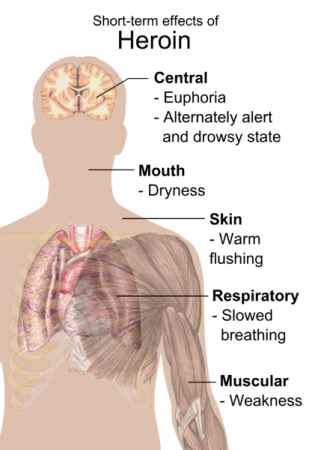More heroin troubles in Oswego, Malone

Image: Mikael Häggström, via Wikimedia Commons
Update, May 14: The Watertown Daily Times is reporting that Oswego Police arrested two men on felony drug charges in relation to the overdoses. That story here.
***
In the last few months, it’s become really obvious that heroin is a growing problem in the North Country (see NCPR’s recent reporting on heroin here.) More on that today in the news:
In Oswego, the Common Council voted Monday night to discontinue a local bar crawl (the Bridge Street Run) after three SUNY Oswego students overdosed on Friday night. Two students were hospitalized, the Watertown Daily Times reports, and one died. The council vote was unanimous, but according to the paper, reaction has been mostly negative to the decision.
In Malone, a forum on drug abuse Monday night aimed to introduce attendees (of which there were about 50) to the world of heroin and other opiates, use of which has been growing locally. That story from the Malone Telegram. Opiate use is rising, according to New York State Police Investigator Samuel Mercado, because of “the availability, the low cost, [and] the purity level.” Prescription opioids like Oxycodone also function as “gateway drugs,” Mercado said.
Beth Lawyer, director of North Star Behavioral Health Services, said the number of people being admitted for heroin use is rising rapidly: “Three years ago, less than 1 percent of our outpatient admissions for substance use treatment were primarily heroin users; today that number is close to 9 percent.”
There’s lots more detail in the article, but one interesting note: Malone is among the numerous towns in New York state to have requested Narcan, an opioid antidote that reverses the effects of the drugs in a few minutes, from the state. Funding for Narcan is available through a program through the Attorney General’s office. Malone’s not alone in the North Country: Lowville, Norwood and Moriah have also requested the kits. Malone’s police are training to use Narcan next Wednesday.








We keep hearing the propaganda about how marijuana is a “gateway drug” to worse drugs. But it seems that the real gateway drugs are legal.
The concept of “gateway drugs” as an explanation for more serious drug abuse is nonsense, at least in the sense of “if you do THIS, then you’ll progress to THAT.” What’s more important are “gateway behaviors.” Long observed family behaviors, ineffective and damaging coping mechanisms and self-medication, for example, are behaviors that can start one on the road to addiction, whatever that addicition turns out to be. Blaming pharmaceutical companies or out-of-town dealers is a simplistic answer and serves only to distract from the real causes of addiction, which are much more complicated.
Well certainly addiction cycles are often within the family, but not always.
However, we do know for certain that we did not have an out of control opiate problem until the advent of opiate pain pills which were massively over used and over-prescribed.
Now maybe those people would have become addicted to alcohol or something else? But maybe not, if you listen to the stories of those who have become addicted to pain pills and then changed to heroin, they are often people who do not have addiction histories, but people who had a surgery or a back issue or an injury and were prescribed opiates for long term use.
Addicts need to take responsibility for their own actions instead of blaming their addiction on big pharma, the medical establishment or whoever else they can think of. The abrogation of individual responsibility is the problem here.
Larry, I don’t think individual addicts are sitting around saying “Big Pharma made me do it.” But looking at the rise of opiate abuse and how it parallels the rise in prescription opiate sales, it’s hard to avoid the conclusion that there is a strong connection. How do you explain the sudden rise in the “abrogation of individual responsibility” over the last few decades?
Personally, having witnessed a young relative waste the last few years wrestling with addiction, I have the feeling that it’s not just a matter of the wide availability of seemingly safe pain meds, it also has to do with a generation growing up with the “There’s a pill for that” mentality, and that can be pretty clearly laid at the door of advertizing for Big Parma’s wares. For example, kids these days in the best of schools are busily abusing ADD meds, often with their parents’ knowledge, when they have a paper to write or a test to study for, and they feel that if they don’t, they’ll be at a competitive disadvantage.
It’s hard not to long for the days when neither doctors nor lawyers nor drug companies advertized their wares. But of course, there’s big money to be made, so damn the torpedoes!
Its a combination. Certainly from an individual perspective, it does no good for an addict to blame others for the situation, after they are done blaming they are still an addict and dying, it is not helping them to find excuses for the addiction.
On the other hand from a social standpoint, the attitude that walker is talking about is a real problem and if that attitude is actually encouraged and fed by business interests who make a substantial profit from addiction, that also needs to be addressed.
I don’t think drug companies should be allowed to do direct marketing to consumers, we are not equipped to know what drugs we need, the advertisements all tell us that we need many drugs. Low T, weight loss, sleep problems, anxiety problems, and on and on. We have drugs in search of a problem.